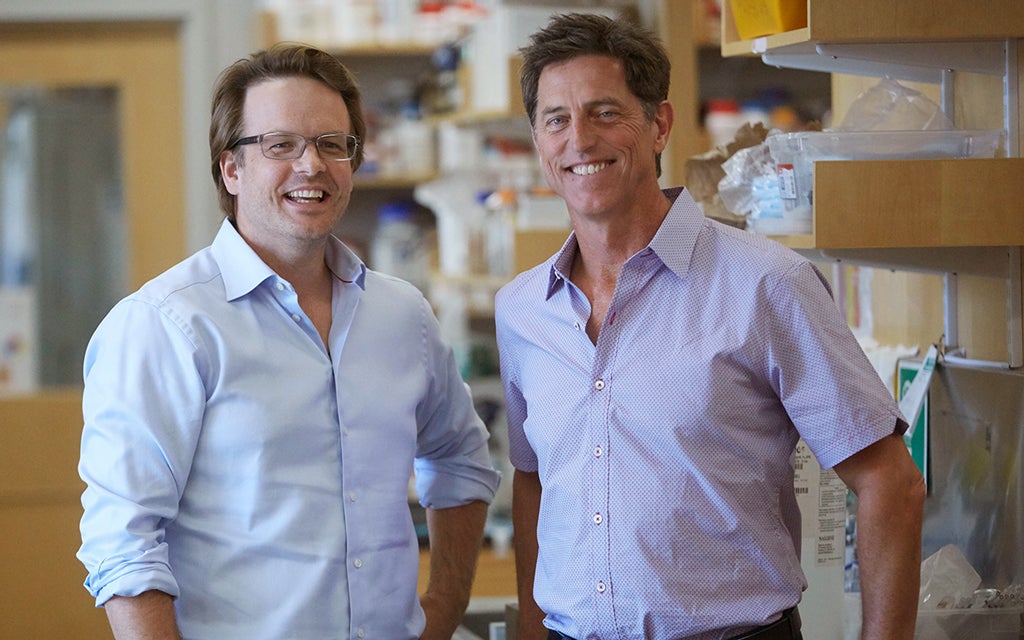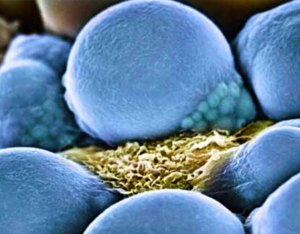
Robert Farese and Tobias Walther’s unusual lab is cracking the secrets to diseases ranging from diabetes to dementia.
In the little conference room that connects the offices of Robert Farese Jr. and Tobias Walther, both professors of genetics and complex diseases at Harvard T.H. Chan School of Public Health, the table is strewn with toys. Turn one over and blue droplets form and disperse through yellow liquid. It’s a tribute to lipid droplets, the fat-storing organelles in cells that inspired the two researchers to begin collaborating more than 10 years ago and that remain a central focus of their work.
Next to the droplet toy is a pendulum hovering over a wheel of answers: Yes. No. Maybe. Try Again. People may well wonder if the scientists ever have to consult it for guidance. Probably not. Since they arrived at the School in 2014, Farese and Walther have been running their lab as equal partners, sharing the decisionmaking around everything from setting research goals to advising graduate students.
After nearly two years, they’re still fielding questions about how their joint lab works—and figuring out for themselves how a high-powered academic enterprise can operate under an ethos built on principles of interdependence and emotional relatedness. As Farese sees it, “We’re creating our own brand of science.”
A SCIENTIFIC LENNON AND MCCARTNEY
In this creative partnership, Walther would perhaps be the Lennon to Farese’s McCartney. In a joint interview, Walther comes across as direct and intense, while Farese projects the affable casualness of a man who has spent much of his life in sunny climates. Yet while Walther is quicker to talk, he often pauses to give Farese a chance to jump in and tweak the verse.
Without prompting, both scientists explain that what they come up with together is different from the work either would do on his own. “It would be like if he wrote a song and I wrote a song, and then we wrote one together,” says Farese. “All three would be completely different”—but the third song, he suggests, might be the one to top the charts.
Walther says, “If I can’t convince my best science friend that something is important and should be done, then there is a serious problem. If we’re both excited about an idea, and we’re still excited a month later, it’s probably a good idea.”
As in any good relationship, Farese and Walther see eye to eye where it counts but have enough differences to keep things interesting. Farese trained as a physician in internal medicine before moving into research in metabolism and endocrinology at the University of California, San Francisco (UCSF), and the Gladstone Institutes. After about 10 years running a lab, he hit a point where he became hungry for new ways to think about his work. In 2005, he went on sabbatical and joined a cell biology lab at UCSF.
Things went even better than expected. One day, he sat down next to Walther, then a postdoctoral researcher in the lab, and intellectual sparks flew. Early on, they discovered that while they may come at the work from different perspectives, their views on the values behind good science were very much in sync.
“We have similar taste in science. We value causality over correlation,” Walther says. “We’re not satisfied with scratching the surface, and we challenge each other and our lab members on clarity. I think we both have a pretty strong allergy to intellectual mud.”
The lipid droplet system is a boon to the body in times of hunger, but it can break down when people gain and retain excess weight.
Their collaboration continued after Walther left UCSF and went on to form his own labs, first in his native Germany and later at Yale. He and Farese chatted over Skype, cowrote papers over email, and worked to establish trusting relationships between their respective lab members. They both soon realized, however, that it was a lot to ask a graduate student to share hard-won research results with a stranger on another continent. Skype was not going to cut it, so exchange visits were arranged. After their joint lab at Harvard Chan became home, their research families were thrown together and have adjusted to daily life together like a scientific Brady Bunch. Today, more than half of the lab is jointly hired.
PIONEERS IN LIPID RESEARCH
The collaboration has proven undeniably fruitful. The researchers and their teams have identified more than 200 genes that regulate lipid storage and govern lipid droplet biology. They have focused primarily on the droplets that form to store lipids in adipocyte cells for later conversion into energy, and that likely also protect cells throughout the body from the harmful effects of too much dietary fat.
The lipid droplet (LD) system is a boon to the body in times of hunger, but it can break down when people gain and retain excess weight. LD production overwhelms the adipocytes, and the excess organelles spill into circulation and deposit themselves in other locations such as the liver and heart, where storage space is limited. This spillover effect interferes with the body’s ability to process glucose, resulting in type 2 diabetes and other cellular malfunctions that often lead to heart and blood vessel damage. Put simply, “When the little balls of fat that float in our cells grow and accumulate excessively,” Walther says, “they can give rise to a variety of health problems.”
Farese and Walther have been pioneers in the field, and among other important discoveries have identified two classes of LDs: small static droplets and larger droplets that expand as needed. They showed how enzymes involved in synthesis of triglycerides (one type of lipid stored in the droplets) locate and engage with the expanding droplets to build new triglycerides. And they found protein complexes that mediate trafficking of lipid droplets around the cell and are important for lipid homeostasis. Greater understanding of the way cells store fats and oils could prove key not only to tackling metabolic diseases but also to engineering plants and microorganisms for increased biofuel production.
PARKINSON’S TO ALS: THE LIPID CONNECTION
“[M]any diseases such as obesity, diabetes, and fatty liver disease could be referred to as diseases of excessive LDs,” Farese and Walther wrote in a 2009 Cell paper. They titled the paper “Lipid Droplets Finally Get a Little R-E-S-PE-C-T,” reflecting not only the shift in scientific consensus that LDs are dynamic biological structures but also the lightheartedness that suffuses their relationship.
Last year, their lab got more than a little respect of its own when Walther was named an investigator by the Howard Hughes Medical Institute. The prestigious fiveyear appointment provides both scientists with a rare bit of breathing room in terms of research funding and the opportunity to push forward with aspects of their work that have a potentially longer timeline.
An emerging area of focus for the lab is the mechanisms behind neurological and neurodegenerative diseases. While still at UCSF, Farese cofounded the Consortium for Frontotemporal Dementia (FTD) Research, which aims to identify cures for FTD—a group of progressive brain disorders that typically strike people still in their prime—through systematic collaboration between best-in-class researchers. An estimated 60,000 Americans are affected. Farese’s group has been studying progranulin, a protein deficient in some forms of FTD. Other research in this area builds off work from Walther’s lab at Yale looking at how protein mutations can lead to neurological diseases such as Parkinson’s and amyotrophic lateral sclerosis, or Lou Gehrig’s disease. What appeared to be diverse interests have now fused, in a completely unplanned manner, in the new joint lab.
“IF MY TEAMMATES WIN, I WIN.”
Their highly relational style extends to the entire lab. Young scientists work in subgroups focused on particular areas, such as biochemistry or cell biology—“different approaches to the problems,” Farese says. Each lab member has his or her own project, but all are expected to collaborate and share expertise within their groups and are encouraged to engage with the work of the rest of the lab and Harvard’s wider scientific world.

“It’s so easy to generate data,” Walther explains. “But the scientific process is to make the connections between the data and generate insights. That often comes from places where you don’t expect it. I come from labs where people talk to each other and spend a lot of time discussing science with a high intensity. That’s the kind of culture we’re trying to foster.”
Comparing the task of building a lab to building a basketball team, Farese says, “Running a science lab is a very challenging task. You’ve got 18 people, and each of them has their own project. There may be a common overarching goal that we set, but each person’s definition of success is tied to his or her own success more than the team’s. How do you get people to pull together? We want people to buy into the idea that collaborative interaction leads to a better outcome for everyone. If my teammate wins, I win. If the group wins, I win.”
Farese describes himself as a student of how good labs work. A guiding light for both researchers is the scientific partnership of lipid metabolism researchers Michael Brown and Joseph Goldstein at the University of Texas Southwestern Medical Center, a 40-year collaboration that led to a Nobel Prize and the development of statin drugs to control cholesterol. In addition to scientific achievement at the highest level, the lab’s other lasting legacy is a culture of curiosity and collaboration that has carried on through the researchers’ many mentees.
FROM INDIVIDUAL EXPERIMENT TO SEEING THE WHOLE STORY
Farese and Walther hope to leave a similar scientific bequest (though they are quick to say they feel nowhere in this league), both in research translated into ways to help people and in researchers trained in conducting good science. And investigators can’t do meaningful work in isolation, Walther cautions. As he asks his graduate students, “How do you go from the individual experiment to seeing the whole story? Once you see the whole story, how do you present it? How do you make sure that you’re communicating clearly with other people why you are excited about it?”
Even after 10 years of collaboration, Walther and Farese’s own excitement about their work is palpable. Interviewed together, they spark off each other’s ideas, building off each other’s stories with the familiarity of old friends. And they remain ever curious about the next chapter in their novel lab’s scientific story.
Walther recalled the words of Peter Walter, who ran the lab where he and Farese met—an environment that fostered curiosity and creative collaboration. “The world is full of wonders,” their mutual mentor said. “Every time you turn over a stone, there is something amazing lurking under it.”
Amy Roeder is assistant editor of Harvard Public Health.







